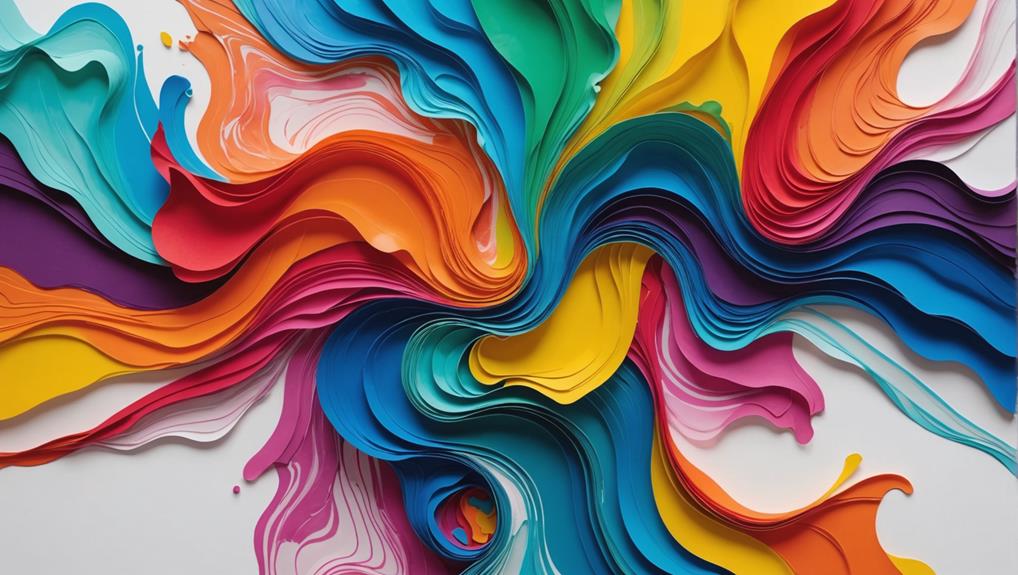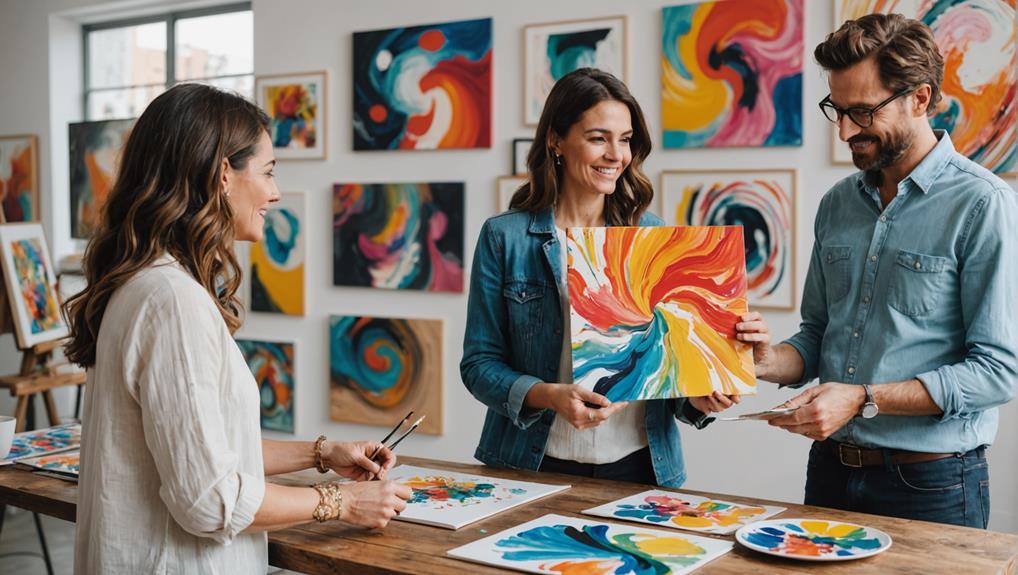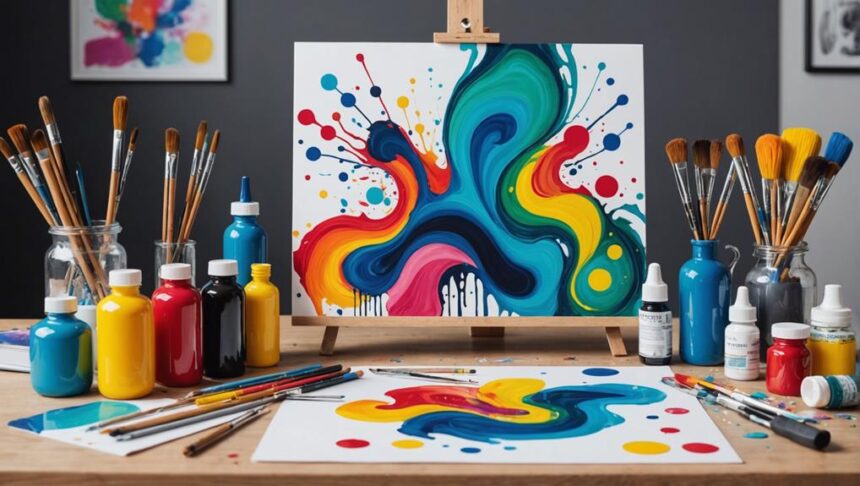Art licensing can be a game-changer for your fluid art business! Envision this: you create stunning, colorful pieces, and instead of just selling originals, you license your artwork to manufacturers. This means they can put your art on products like phone cases or apparel, and you earn royalties. It's like having a money-making machine while you keep painting! Besides bringing in passive income, licensing boosts your exposure as brands market your art for you. Imagine your creations reaching audiences you never dreamed of, all while you stay focused on what you love. Curious to learn how to get started and protect your artwork?
Key Takeaways
- Art licensing allows artists to earn passive income by granting manufacturers usage rights in exchange for royalties or fees.
- Licensing agreements expand audience reach and visibility, enhancing the artist's market presence.
- Artists retain ownership of their work while protecting intellectual property through clearly defined agreements.
- Collaborating with established brands through licensing can significantly boost the artist's earnings and market exposure.
What Is Art Licensing?
Art licensing is a contractual agreement where an artist permits a manufacturer to use their artwork on products in exchange for royalties or fees. This practice has a rich licensing history, evolving as a key avenue for artists to monetize their creativity beyond traditional methods.
Fundamentally, it allows artists to retain ownership of their art while granting the rights to use it, ensuring artist rights are protected.
Imagine creating a beautiful painting and then seeing it on mugs, t-shirts, or notebooks—without having to produce or sell these items yourself. That's the magic of art licensing! Artists can earn passive income by licensing their artwork, and agreements usually detail things like how long the manufacturer can use the art, how much the artist will get paid, and what percentage of sales they'll receive. Typically, this commission ranges from 3% to 10% of the wholesale price.
Platforms like Society6 and Creative Market make it easier for artists to showcase their designs to potential manufacturers. This not only brings in income but also helps artists gain visibility and build their brand.
Art licensing turns creativity into a sustainable business, all while maintaining the artist's rights.
Key Benefits of Licensing
Licensing offers artists multiple advantages, including the ability to generate passive income and increase their exposure through diverse product placements. By licensing their artwork, fluid artists can earn royalties ranging from 3% to 10% of the wholesale price on products that feature their designs. This steady stream of income allows artists to focus on their craft, without the constant pressure of making direct sales.
Moreover, licensing helps artists expand their audience reach well beyond their personal sales channels. Imagine seeing your art on home decor items or stationery in popular retail stores! This enhanced exposure is a fantastic way to tap into current art trends and get your name out there. Engaging in licensing agreements also means that artists can protect their intellectual property, as these agreements clearly outline the terms of usage and payment structures.
Another perk is the opportunity to collaborate with established brands, which can greatly boost your visibility. Imagine partnering with big names like Target or Anthropologie! Plus, manufacturers often handle the marketing, meaning you can spend more time creating and less time worrying about promotion. Market research shows that these collaborations can lead to long-term partnerships and open up even more opportunities.
Financial Opportunities
Exploring financial opportunities in art licensing reveals how fluid artists can generate passive income and diversify their revenue streams.
By earning royalties each time their artwork is used on products or through upfront payments and advances, artists can benefit financially without losing ownership of their work.
Additionally, licensing deals with well-known brands and multiple manufacturers can greatly enhance an artist's earning potential and create multiple revenue channels.
Passive Income Potential
By leveraging art licensing agreements, artists can access substantial passive income opportunities through royalties and collaborations.
Understanding royalty structures is essential; typically, artists earn between 3% to 10% of the wholesale price of products featuring their designs. Keeping an eye on market trends is equally important, as they can influence the demand for specific types of artwork and help artists make informed decisions about which products to license.
Licensing fluid art designs to manufacturers or retailers can be a game-changer. Imagine your artwork on home decor, stationery, or even clothing, generating income without the need for direct sales efforts! It's like planting a seed and watching it grow while you focus on creating more beautiful pieces.
Print-on-demand platforms can also help you reach a wider audience, allowing you to earn from each sale while retaining ownership of your original artwork.
Successful agreements might even lead to collaborations with major brands, providing significant financial opportunities and boosting visibility in the market.
Diversifying Revenue Streams
Artists can markedly enhance their financial stability and growth by leveraging art licensing to diversify their revenue streams, capitalizing on various market opportunities beyond direct sales.
Imagine turning your unused fluid art pieces into a source of passive income. By licensing your designs to manufacturers, you can earn royalties, typically ranging from 3% to 10% of the wholesale price, for products featuring your artwork. This means that even when you're not actively creating, your art is still working for you, bringing in money.
Market trends show a growing demand for unique, artistic designs on everyday items. By understanding your target audience, you can tailor your art to fit these trends and increase your chances of landing lucrative licensing deals. Collaborating with established brands can markedly boost your visibility and sales, leading to even more financial opportunities.
One of the best parts? Licensing allows you to retain ownership of your artwork while generating income. You can license the same piece to multiple companies for different products, maximizing your earnings. Plus, during those inevitable slow sales periods, consistent royalty income can provide a financial cushion, ensuring you stay afloat.
Preparing Your Artwork
When preparing your artwork for licensing, it's essential to get organized and protect your creations.
By categorizing your pieces into a well-structured portfolio, you make it easier for licensors to see the value in your collections.
Additionally, adding watermarks to your images can safeguard your work from unauthorized use while you negotiate licensing deals, ensuring your intellectual property stays safe.
Organizing Your Portfolio
Creating a well-organized portfolio is essential for efficiently showcasing your fluid art to potential licensees and securing licensing agreements. A strong portfolio presentation demonstrates your professionalism and makes it easier for clients to see the potential of your work. Thematic organization can be particularly effective, helping licensees quickly identify pieces that align with their needs.
Here are some key steps to contemplate:
- Categorize Your Artwork: Organize your fluid art by themes, colors, and styles. This thematic organization will streamline the selection process for potential licensees and highlight the versatility of your work.
- Regular Updates: Keep your portfolio fresh by regularly adding new pieces. This guarantees that your offerings remain relevant and appealing to manufacturers looking for current trends in fluid art.
- Mock-Ups: Include mock-ups of your art on various products, like home decor or stationery. This visual demonstration helps potential licensees envision how your designs can be applied, making your portfolio more engaging and practical.
- High-Quality Images: Maintain high-quality images of your artwork, including watermarked versions for initial inquiries. This not only showcases your work effectively but also protects your intellectual property during the selection process.
Protecting Your Artwork
Properly protecting your artwork is fundamental to guaranteeing your creative efforts are legally safeguarded and effectively monetized. Imagine pouring your heart and soul into a stunning piece of fluid art, only to see it copied and sold by someone else. That's where copyright registration comes in. Think of it as a shield that legally proves you own your artwork. Without it, you're like a knight without armor, vulnerable to potential infringement.
But that's not all. Before you even get to the licensing stage, image watermarking is your first line of defense. It's like putting a 'Do Not Touch' sign on your work, deterring unauthorized copying and making certain everyone knows that masterpiece is yours.
Keeping detailed records of all licensing agreements and communications is another essential step. It's like having a roadmap that helps you track where your artwork is being used and guarantees that your rights are always protected. Understanding the terms in these agreements is also critical, allowing you to retain control over your art while making money from it.
Lastly, regularly updating your portfolio and tracking your artwork's market performance helps you stay ahead of the game, adapting your strategy to protect your brand's integrity.
Navigating Licensing Agreements

Maneuvering licensing agreements requires a thorough understanding of contractual terms to guarantee that both the artist's and manufacturer's interests are adequately protected. When it comes to licensing strategies, it's essential to focus on agreement essentials to secure a fair and beneficial partnership. Here are some key points to reflect on:
- Royalty Rates: Typically, royalty rates in licensing agreements range from 3% to 10% of the wholesale price. Negotiate based on the market value and demand for your artwork to obtain a rate that reflects its worth.
- Exclusivity Clauses: These can greatly impact your revenue potential. Weigh the benefits of exclusive deals—which might offer higher royalties—against broader exposure through non-exclusive agreements.
- Copyright Ownership: Always retain ownership of your copyright. This allows you to license the same artwork to multiple companies, maximizing your income streams.
- Regular Reviews: Regularly reviewing and updating your licensing agreements is vital. This helps you adapt to market changes, maintain compliance, and sustain a positive relationship with your licensees.
Finding Licensing Platforms
Once you have a solid understanding of licensing agreements, the next step is finding the right platforms to showcase and license your art. Popular platforms such as Society6, Creative Market, and Art Licensing International allow artists to display their fluid art while retaining ownership. These platforms cater to current market trends, offering artists an avenue to increase their visibility and potential revenue streams.
Print-on-demand services like Redbubble and Zazzle are also excellent choices. They enable you to sell your designs on a variety of products without any upfront costs, making it easier to immerse yourself in the licensing market. Additionally, platforms like Etsy can help you reach a larger audience, connecting you with potential buyers interested in custom commissions or licensed products.
When it comes to platform comparisons, it's essential to reflect on what each site offers regarding promotional tools and resources. Many online marketplaces provide these tools to help you market your work effectively.
Crafting Your Pitch

Crafting an effective pitch for art licensing requires a strategic approach that highlights the unique value and market potential of your fluid art. To guarantee your pitch stands out, it's essential to align your artwork with the values and aesthetic of the brand you're targeting.
Here's a concise strategy to help you craft an impactful pitch:
- Present a Cohesive Collection: Showcase a themed collection of 4 to 10 pieces. Companies prefer collections that can be applied across various product lines, making your work versatile and appealing.
- Research and Align: Thoroughly research the company to understand their target audience and brand alignment. Tailor your pitch to demonstrate how your fluid art complements their existing products and meets market demands.
- Professional Online Portfolio: Instead of attaching image files, include links to an online portfolio. This approach not only makes it easier for potential partners to view your work but also enhances your professional appeal.
- Emphasize Mutual Benefits: Highlight how your art can enhance their brand visibility and product offerings. Make it clear how both parties can benefit from the licensing agreement, expanding your reach in the market.
Negotiating Terms
After presenting a compelling pitch, the next step is negotiating the terms of the art licensing agreement to guarantee a mutually beneficial partnership.
One of the first things to discuss is the royalty structures. Artists typically earn royalties ranging from 4% to 30%, depending on the product type and market conditions. Make certain these rates are clearly defined in your agreement to avoid any confusion later on.
Another critical point is the exclusivity clauses. While it might seem tempting to grant exclusive rights to one company, remember that this can limit your ability to license your work to others in specific markets or territories. Weigh the pros and cons carefully before committing.
Don't forget to negotiate the retention of copyright ownership. This guarantees you keep the rights to your artwork while granting usage rights to the licensee.
It's also essential to discuss the duration of the licensing agreement, which generally spans 1 to 3 years. This allows you to reassess and renegotiate terms based on market performance.
Clear communication about expectations, including the scope of usage and promotional efforts by the licensee, is key. This helps prevent misunderstandings and fosters a successful partnership.
Common Challenges

Maneuvering the intricacies of art licensing agreements presents several common challenges that artists must address to protect their interests and guarantee successful collaborations. These challenges can be intimidating, but understanding them can make the process smoother.
1. Navigating Complex Agreements:
Licensing agreements can be tricky, often filled with legal jargon. Seeking legal advice can help you understand terms and make sure you retain your rights. Watch out for exclusivity clauses that might limit your opportunities elsewhere.
2. Determining Fair Royalty Rates:
Figuring out what royalty rates are fair can be a head-scratcher. Rates can range from 4% to 30%, so thorough market research is essential. Knowing what others in your niche are getting can help you negotiate better deals.
3. Managing Promotions and Marketing:
Licensing isn't just about signing a contract and waiting for the checks to roll in. You need to actively promote and market your work, which can be time-consuming. Balancing this with creating new art can be challenging.
4. Keeping an Updated Portfolio:
A well-organized, current portfolio is important. Without it, securing deals and effectively presenting your work to potential licensees becomes difficult. Trends and consumer preferences change quickly, so staying updated is critical.
Frequently Asked Questions
What Is the Importance of Copyrighting Artwork?
Copyright registration is essential as it provides infringement protection and enhances legal standing, enabling artists to sue for damages. It also serves as public notice of ownership, deterring unauthorized use and safeguarding the artist's financial interests.
What Is Art Licencing?
Art licensing involves licensing agreements between artists and manufacturers, allowing the use of the artist's work on products. This arrangement provides art licensing benefits such as royalties, increased visibility, and potential collaborations, while artists retain ownership of their work.
How Can I Make My Art Business Successful?
To make your art business successful, implement effective marketing strategies and enhance customer engagement. Establish a diverse product line, maintain an updated portfolio, and leverage social media to increase visibility and attract potential collaborations.
What Is an Example of an Artistic License?
An example of an artistic license is a fluid artist entering into licensing agreements with a home goods retailer, allowing the retailer to feature the artist's designs on kitchenware, thereby ensuring artistic freedom and generating passive income through royalties.
Conclusion
Art licensing offers substantial benefits to fluid art businesses through financial opportunities, brand expansion, and enhanced market reach.
By understanding the intricacies of licensing agreements, preparing artwork meticulously, and steering platforms effectively, artists can maximize their potential earnings.
Crafting a compelling pitch and negotiating favorable terms are essential skills for mitigating common challenges.
Ultimately, art licensing serves as a powerful tool for artists seeking to monetize their creativity and gain greater exposure in the market.


Leave a Reply